Analysis of Factors Impacting Employee Weekly Income
VerifiedAdded on 2022/05/25
|28
|5343
|33
Report
AI Summary
This report presents an analysis of the factors influencing employee weekly income, based on an online survey of 100 individuals. The study employs LASSO and LAR models to identify significant variables. The analysis reveals that age, sex, qualification, and time spent working are correlated with income, while ethnicity shows no significant association. The report includes descriptive statistics on population characteristics like age, sex, and ethnicity, along with correlation analysis and regression model results. The findings suggest that highly skilled, experienced employees, working longer hours, and focusing on employing more men can positively impact weekly income. The study concludes with limitations, recommendations, and references to support the findings.
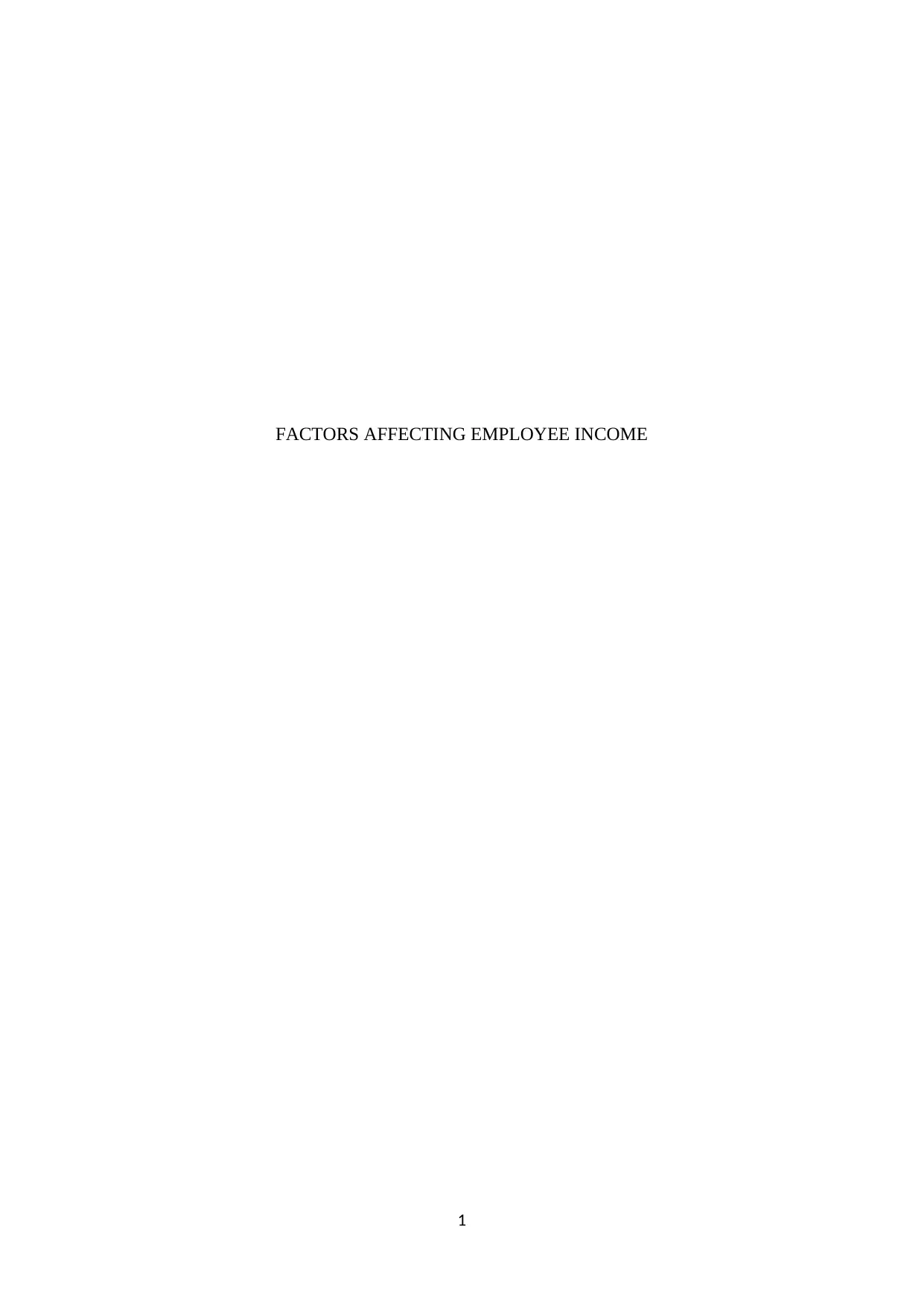
FACTORS AFFECTING EMPLOYEE INCOME
1
1
Paraphrase This Document
Need a fresh take? Get an instant paraphrase of this document with our AI Paraphraser
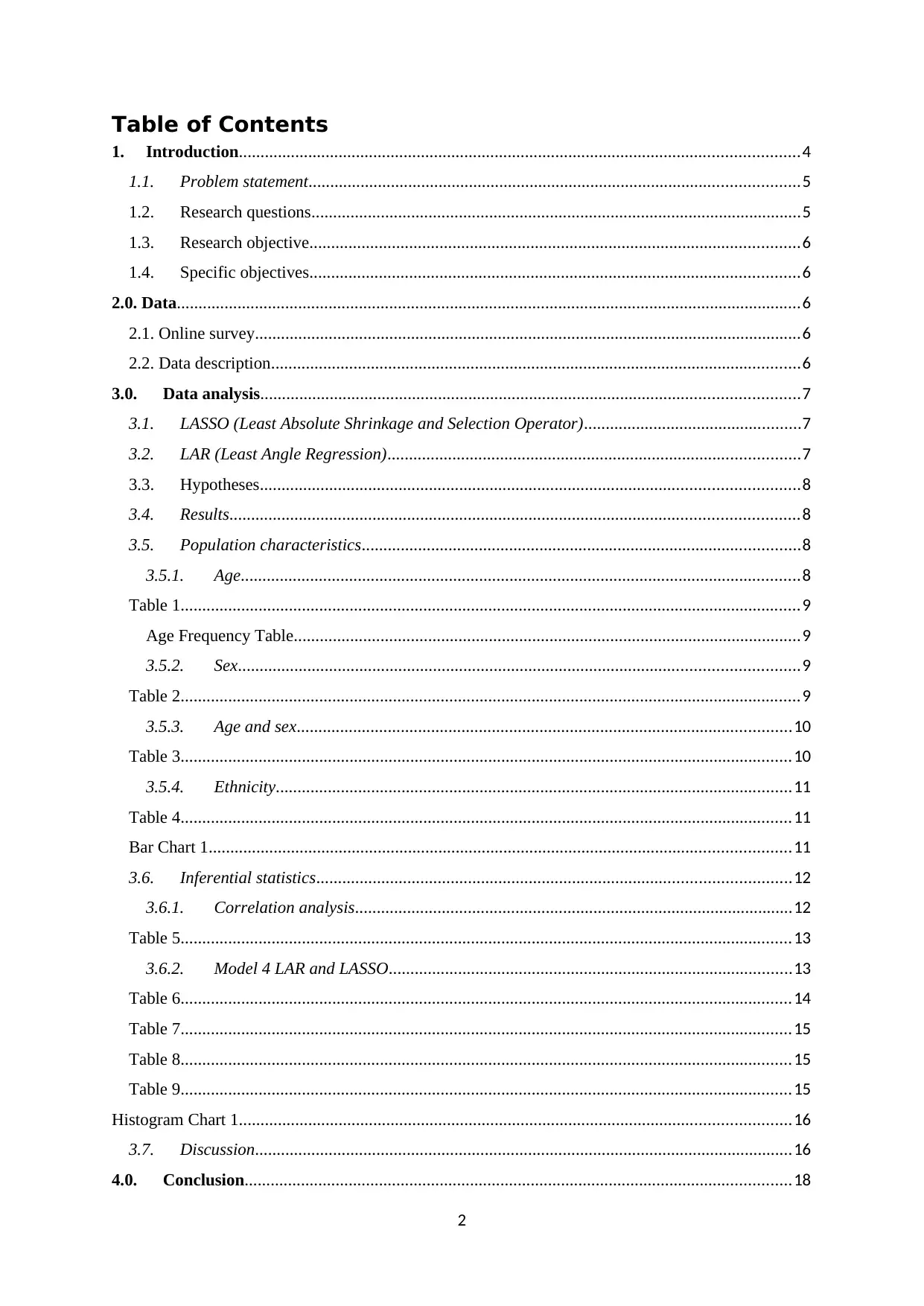
Table of Contents
1. Introduction.................................................................................................................................4
1.1. Problem statement.................................................................................................................5
1.2. Research questions.................................................................................................................5
1.3. Research objective.................................................................................................................6
1.4. Specific objectives.................................................................................................................6
2.0. Data................................................................................................................................................6
2.1. Online survey..............................................................................................................................6
2.2. Data description..........................................................................................................................6
3.0. Data analysis............................................................................................................................7
3.1. LASSO (Least Absolute Shrinkage and Selection Operator)..................................................7
3.2. LAR (Least Angle Regression)...............................................................................................7
3.3. Hypotheses............................................................................................................................8
3.4. Results...................................................................................................................................8
3.5. Population characteristics.....................................................................................................8
3.5.1. Age.................................................................................................................................8
Table 1...............................................................................................................................................9
Age Frequency Table.....................................................................................................................9
3.5.2. Sex.................................................................................................................................9
Table 2...............................................................................................................................................9
3.5.3. Age and sex..................................................................................................................10
Table 3.............................................................................................................................................10
3.5.4. Ethnicity.......................................................................................................................11
Table 4.............................................................................................................................................11
Bar Chart 1......................................................................................................................................11
3.6. Inferential statistics.............................................................................................................12
3.6.1. Correlation analysis.....................................................................................................12
Table 5.............................................................................................................................................13
3.6.2. Model 4 LAR and LASSO.............................................................................................13
Table 6.............................................................................................................................................14
Table 7.............................................................................................................................................15
Table 8.............................................................................................................................................15
Table 9.............................................................................................................................................15
Histogram Chart 1...............................................................................................................................16
3.7. Discussion............................................................................................................................16
4.0. Conclusion..............................................................................................................................18
2
1. Introduction.................................................................................................................................4
1.1. Problem statement.................................................................................................................5
1.2. Research questions.................................................................................................................5
1.3. Research objective.................................................................................................................6
1.4. Specific objectives.................................................................................................................6
2.0. Data................................................................................................................................................6
2.1. Online survey..............................................................................................................................6
2.2. Data description..........................................................................................................................6
3.0. Data analysis............................................................................................................................7
3.1. LASSO (Least Absolute Shrinkage and Selection Operator)..................................................7
3.2. LAR (Least Angle Regression)...............................................................................................7
3.3. Hypotheses............................................................................................................................8
3.4. Results...................................................................................................................................8
3.5. Population characteristics.....................................................................................................8
3.5.1. Age.................................................................................................................................8
Table 1...............................................................................................................................................9
Age Frequency Table.....................................................................................................................9
3.5.2. Sex.................................................................................................................................9
Table 2...............................................................................................................................................9
3.5.3. Age and sex..................................................................................................................10
Table 3.............................................................................................................................................10
3.5.4. Ethnicity.......................................................................................................................11
Table 4.............................................................................................................................................11
Bar Chart 1......................................................................................................................................11
3.6. Inferential statistics.............................................................................................................12
3.6.1. Correlation analysis.....................................................................................................12
Table 5.............................................................................................................................................13
3.6.2. Model 4 LAR and LASSO.............................................................................................13
Table 6.............................................................................................................................................14
Table 7.............................................................................................................................................15
Table 8.............................................................................................................................................15
Table 9.............................................................................................................................................15
Histogram Chart 1...............................................................................................................................16
3.7. Discussion............................................................................................................................16
4.0. Conclusion..............................................................................................................................18
2
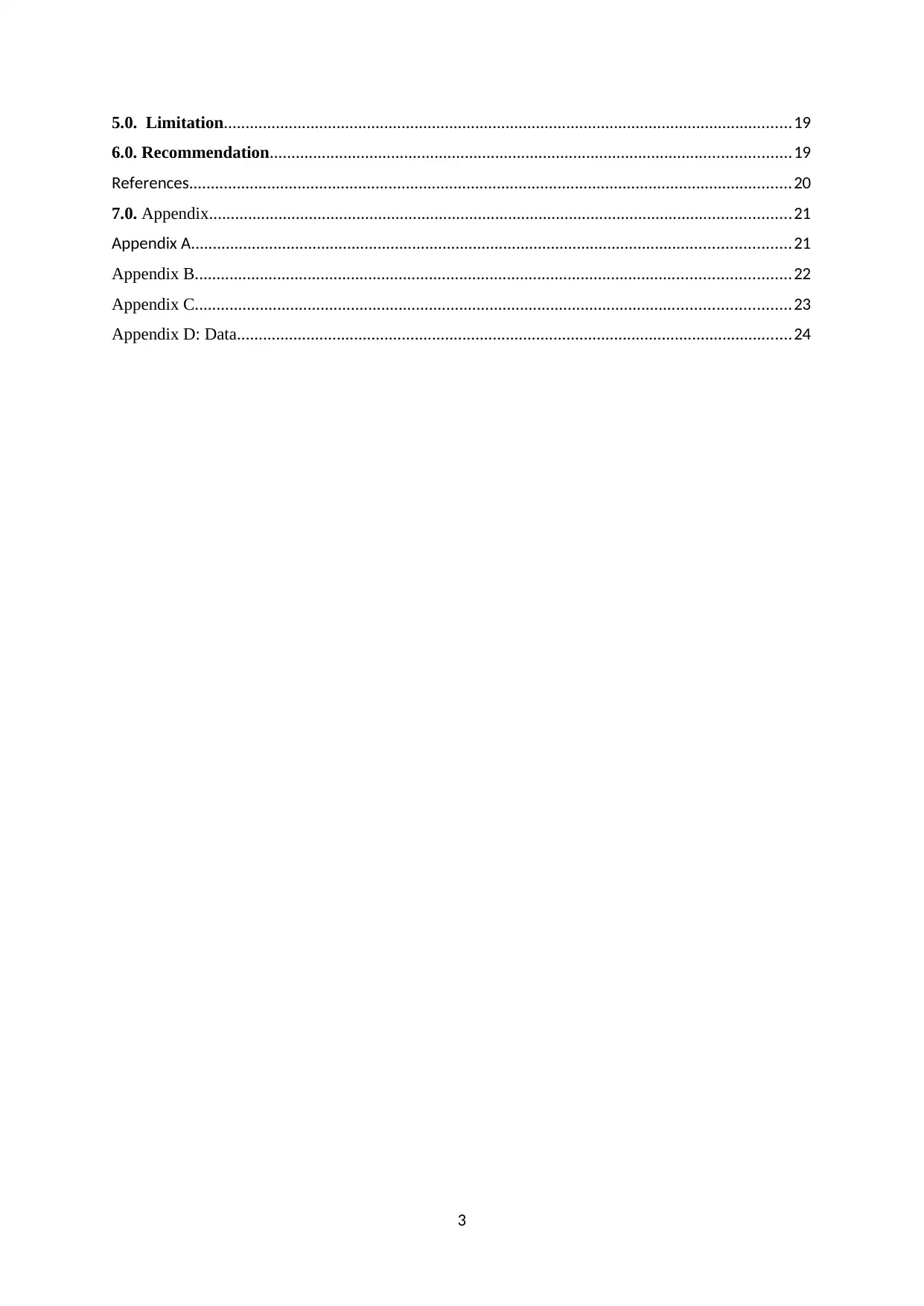
5.0. Limitation...................................................................................................................................19
6.0. Recommendation........................................................................................................................19
References...........................................................................................................................................20
7.0. Appendix......................................................................................................................................21
Appendix A..........................................................................................................................................21
Appendix B.........................................................................................................................................22
Appendix C.........................................................................................................................................23
Appendix D: Data................................................................................................................................24
3
6.0. Recommendation........................................................................................................................19
References...........................................................................................................................................20
7.0. Appendix......................................................................................................................................21
Appendix A..........................................................................................................................................21
Appendix B.........................................................................................................................................22
Appendix C.........................................................................................................................................23
Appendix D: Data................................................................................................................................24
3
⊘ This is a preview!⊘
Do you want full access?
Subscribe today to unlock all pages.

Trusted by 1+ million students worldwide
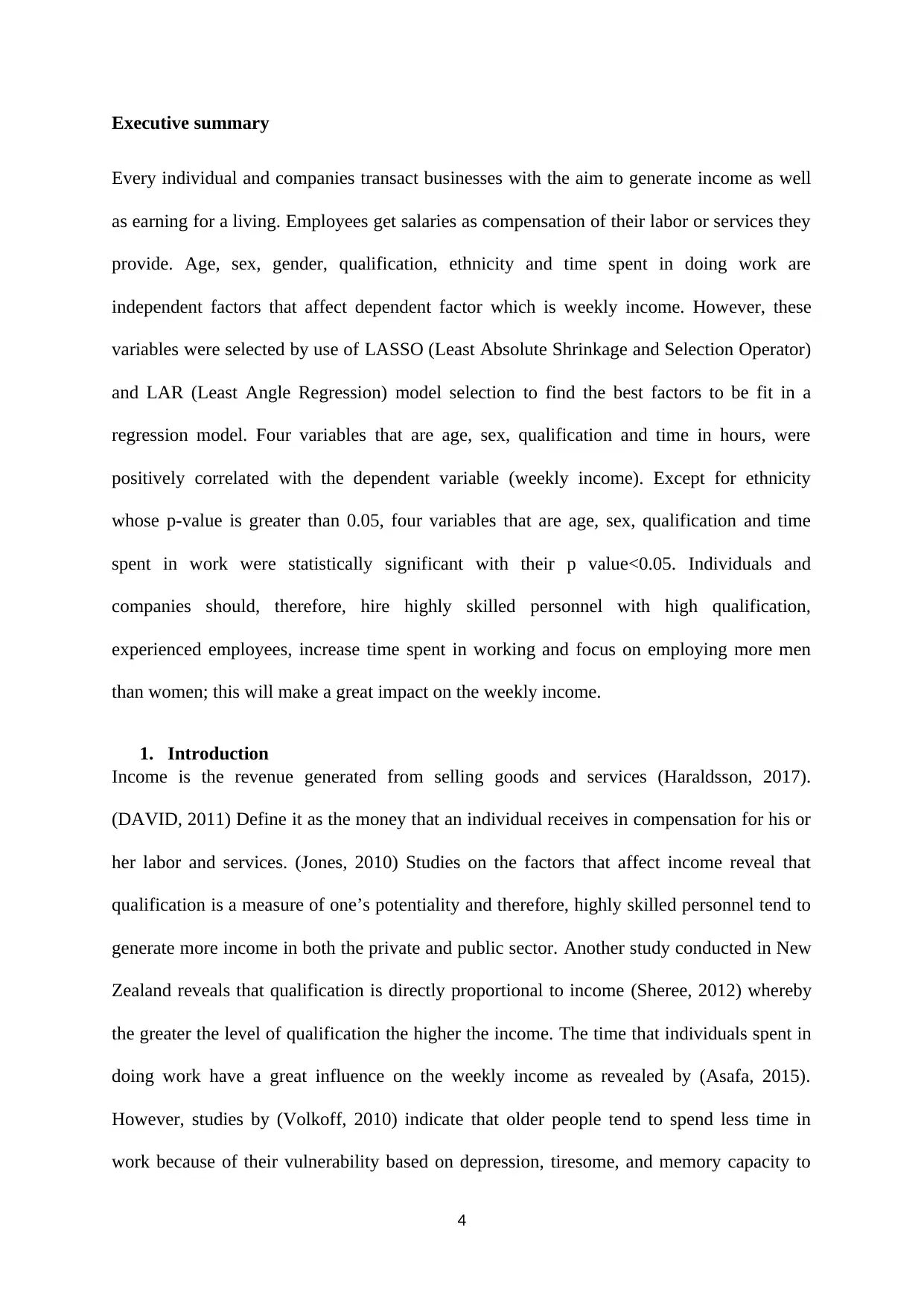
Executive summary
Every individual and companies transact businesses with the aim to generate income as well
as earning for a living. Employees get salaries as compensation of their labor or services they
provide. Age, sex, gender, qualification, ethnicity and time spent in doing work are
independent factors that affect dependent factor which is weekly income. However, these
variables were selected by use of LASSO (Least Absolute Shrinkage and Selection Operator)
and LAR (Least Angle Regression) model selection to find the best factors to be fit in a
regression model. Four variables that are age, sex, qualification and time in hours, were
positively correlated with the dependent variable (weekly income). Except for ethnicity
whose p-value is greater than 0.05, four variables that are age, sex, qualification and time
spent in work were statistically significant with their p value<0.05. Individuals and
companies should, therefore, hire highly skilled personnel with high qualification,
experienced employees, increase time spent in working and focus on employing more men
than women; this will make a great impact on the weekly income.
1. Introduction
Income is the revenue generated from selling goods and services (Haraldsson, 2017).
(DAVID, 2011) Define it as the money that an individual receives in compensation for his or
her labor and services. (Jones, 2010) Studies on the factors that affect income reveal that
qualification is a measure of one’s potentiality and therefore, highly skilled personnel tend to
generate more income in both the private and public sector. Another study conducted in New
Zealand reveals that qualification is directly proportional to income (Sheree, 2012) whereby
the greater the level of qualification the higher the income. The time that individuals spent in
doing work have a great influence on the weekly income as revealed by (Asafa, 2015).
However, studies by (Volkoff, 2010) indicate that older people tend to spend less time in
work because of their vulnerability based on depression, tiresome, and memory capacity to
4
Every individual and companies transact businesses with the aim to generate income as well
as earning for a living. Employees get salaries as compensation of their labor or services they
provide. Age, sex, gender, qualification, ethnicity and time spent in doing work are
independent factors that affect dependent factor which is weekly income. However, these
variables were selected by use of LASSO (Least Absolute Shrinkage and Selection Operator)
and LAR (Least Angle Regression) model selection to find the best factors to be fit in a
regression model. Four variables that are age, sex, qualification and time in hours, were
positively correlated with the dependent variable (weekly income). Except for ethnicity
whose p-value is greater than 0.05, four variables that are age, sex, qualification and time
spent in work were statistically significant with their p value<0.05. Individuals and
companies should, therefore, hire highly skilled personnel with high qualification,
experienced employees, increase time spent in working and focus on employing more men
than women; this will make a great impact on the weekly income.
1. Introduction
Income is the revenue generated from selling goods and services (Haraldsson, 2017).
(DAVID, 2011) Define it as the money that an individual receives in compensation for his or
her labor and services. (Jones, 2010) Studies on the factors that affect income reveal that
qualification is a measure of one’s potentiality and therefore, highly skilled personnel tend to
generate more income in both the private and public sector. Another study conducted in New
Zealand reveals that qualification is directly proportional to income (Sheree, 2012) whereby
the greater the level of qualification the higher the income. The time that individuals spent in
doing work have a great influence on the weekly income as revealed by (Asafa, 2015).
However, studies by (Volkoff, 2010) indicate that older people tend to spend less time in
work because of their vulnerability based on depression, tiresome, and memory capacity to
4
Paraphrase This Document
Need a fresh take? Get an instant paraphrase of this document with our AI Paraphraser
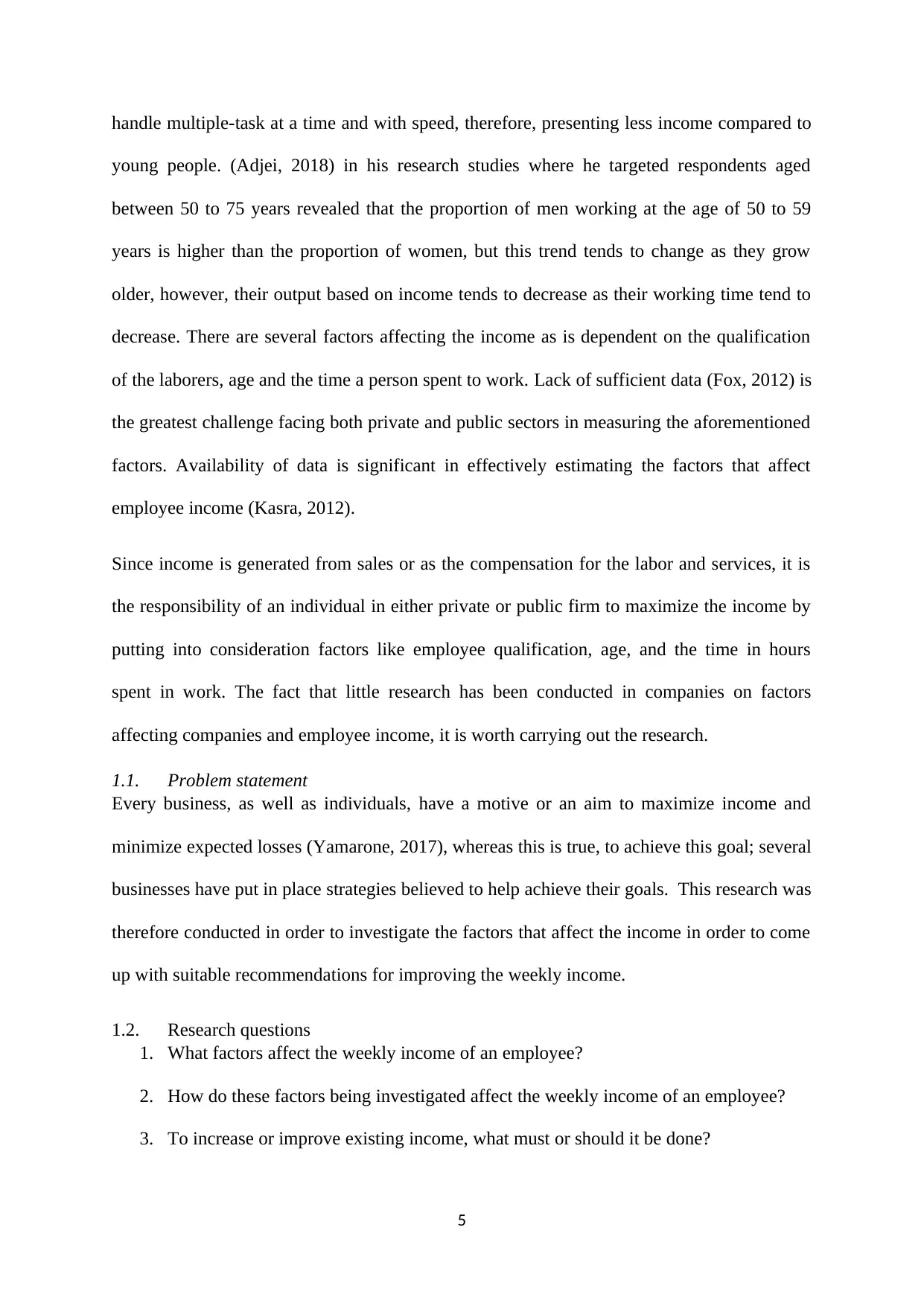
handle multiple-task at a time and with speed, therefore, presenting less income compared to
young people. (Adjei, 2018) in his research studies where he targeted respondents aged
between 50 to 75 years revealed that the proportion of men working at the age of 50 to 59
years is higher than the proportion of women, but this trend tends to change as they grow
older, however, their output based on income tends to decrease as their working time tend to
decrease. There are several factors affecting the income as is dependent on the qualification
of the laborers, age and the time a person spent to work. Lack of sufficient data (Fox, 2012) is
the greatest challenge facing both private and public sectors in measuring the aforementioned
factors. Availability of data is significant in effectively estimating the factors that affect
employee income (Kasra, 2012).
Since income is generated from sales or as the compensation for the labor and services, it is
the responsibility of an individual in either private or public firm to maximize the income by
putting into consideration factors like employee qualification, age, and the time in hours
spent in work. The fact that little research has been conducted in companies on factors
affecting companies and employee income, it is worth carrying out the research.
1.1. Problem statement
Every business, as well as individuals, have a motive or an aim to maximize income and
minimize expected losses (Yamarone, 2017), whereas this is true, to achieve this goal; several
businesses have put in place strategies believed to help achieve their goals. This research was
therefore conducted in order to investigate the factors that affect the income in order to come
up with suitable recommendations for improving the weekly income.
1.2. Research questions
1. What factors affect the weekly income of an employee?
2. How do these factors being investigated affect the weekly income of an employee?
3. To increase or improve existing income, what must or should it be done?
5
young people. (Adjei, 2018) in his research studies where he targeted respondents aged
between 50 to 75 years revealed that the proportion of men working at the age of 50 to 59
years is higher than the proportion of women, but this trend tends to change as they grow
older, however, their output based on income tends to decrease as their working time tend to
decrease. There are several factors affecting the income as is dependent on the qualification
of the laborers, age and the time a person spent to work. Lack of sufficient data (Fox, 2012) is
the greatest challenge facing both private and public sectors in measuring the aforementioned
factors. Availability of data is significant in effectively estimating the factors that affect
employee income (Kasra, 2012).
Since income is generated from sales or as the compensation for the labor and services, it is
the responsibility of an individual in either private or public firm to maximize the income by
putting into consideration factors like employee qualification, age, and the time in hours
spent in work. The fact that little research has been conducted in companies on factors
affecting companies and employee income, it is worth carrying out the research.
1.1. Problem statement
Every business, as well as individuals, have a motive or an aim to maximize income and
minimize expected losses (Yamarone, 2017), whereas this is true, to achieve this goal; several
businesses have put in place strategies believed to help achieve their goals. This research was
therefore conducted in order to investigate the factors that affect the income in order to come
up with suitable recommendations for improving the weekly income.
1.2. Research questions
1. What factors affect the weekly income of an employee?
2. How do these factors being investigated affect the weekly income of an employee?
3. To increase or improve existing income, what must or should it be done?
5
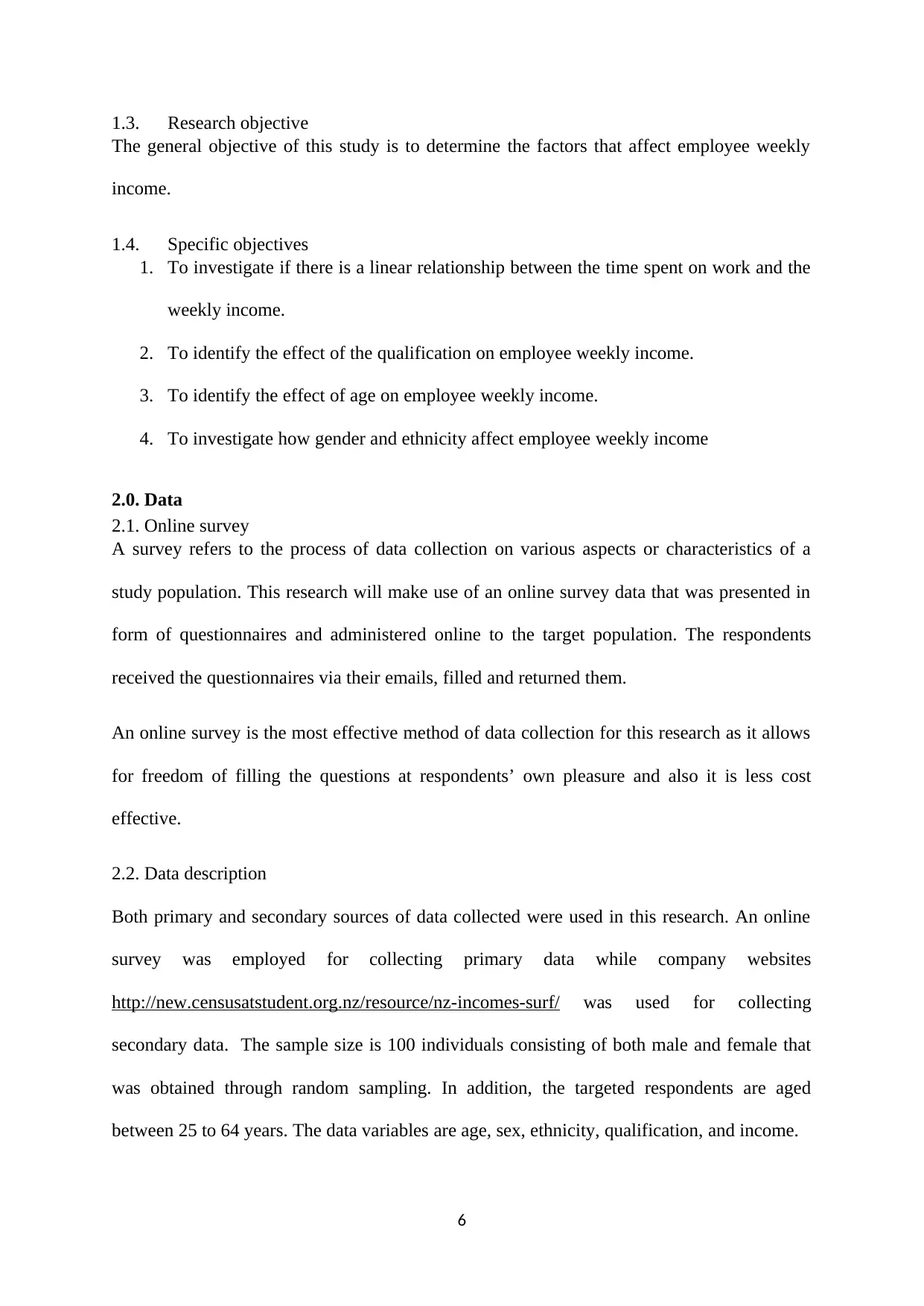
1.3. Research objective
The general objective of this study is to determine the factors that affect employee weekly
income.
1.4. Specific objectives
1. To investigate if there is a linear relationship between the time spent on work and the
weekly income.
2. To identify the effect of the qualification on employee weekly income.
3. To identify the effect of age on employee weekly income.
4. To investigate how gender and ethnicity affect employee weekly income
2.0. Data
2.1. Online survey
A survey refers to the process of data collection on various aspects or characteristics of a
study population. This research will make use of an online survey data that was presented in
form of questionnaires and administered online to the target population. The respondents
received the questionnaires via their emails, filled and returned them.
An online survey is the most effective method of data collection for this research as it allows
for freedom of filling the questions at respondents’ own pleasure and also it is less cost
effective.
2.2. Data description
Both primary and secondary sources of data collected were used in this research. An online
survey was employed for collecting primary data while company websites
http://new.censusatstudent.org.nz/resource/nz-incomes-surf/ was used for collecting
secondary data. The sample size is 100 individuals consisting of both male and female that
was obtained through random sampling. In addition, the targeted respondents are aged
between 25 to 64 years. The data variables are age, sex, ethnicity, qualification, and income.
6
The general objective of this study is to determine the factors that affect employee weekly
income.
1.4. Specific objectives
1. To investigate if there is a linear relationship between the time spent on work and the
weekly income.
2. To identify the effect of the qualification on employee weekly income.
3. To identify the effect of age on employee weekly income.
4. To investigate how gender and ethnicity affect employee weekly income
2.0. Data
2.1. Online survey
A survey refers to the process of data collection on various aspects or characteristics of a
study population. This research will make use of an online survey data that was presented in
form of questionnaires and administered online to the target population. The respondents
received the questionnaires via their emails, filled and returned them.
An online survey is the most effective method of data collection for this research as it allows
for freedom of filling the questions at respondents’ own pleasure and also it is less cost
effective.
2.2. Data description
Both primary and secondary sources of data collected were used in this research. An online
survey was employed for collecting primary data while company websites
http://new.censusatstudent.org.nz/resource/nz-incomes-surf/ was used for collecting
secondary data. The sample size is 100 individuals consisting of both male and female that
was obtained through random sampling. In addition, the targeted respondents are aged
between 25 to 64 years. The data variables are age, sex, ethnicity, qualification, and income.
6
⊘ This is a preview!⊘
Do you want full access?
Subscribe today to unlock all pages.

Trusted by 1+ million students worldwide
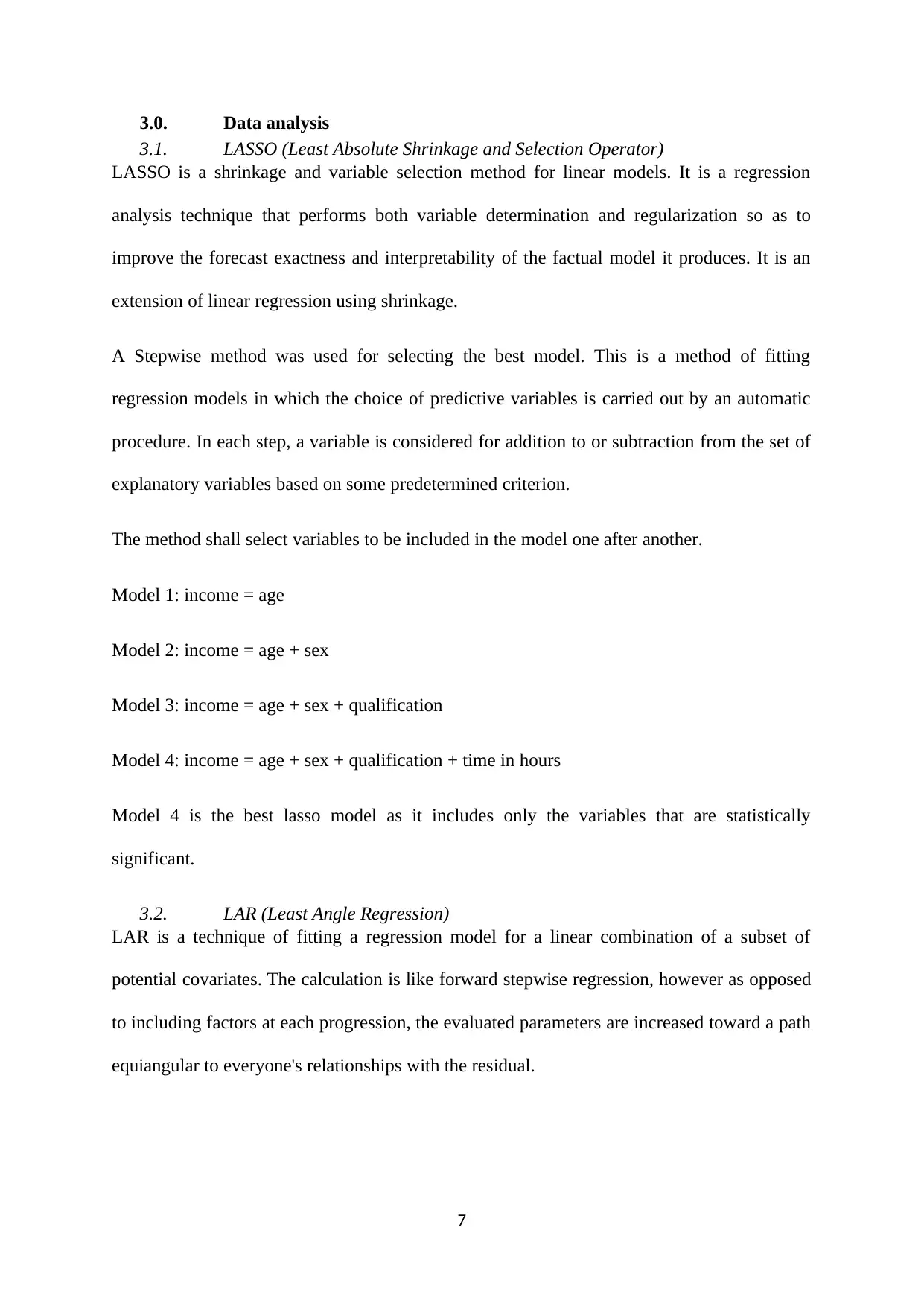
3.0. Data analysis
3.1. LASSO (Least Absolute Shrinkage and Selection Operator)
LASSO is a shrinkage and variable selection method for linear models. It is a regression
analysis technique that performs both variable determination and regularization so as to
improve the forecast exactness and interpretability of the factual model it produces. It is an
extension of linear regression using shrinkage.
A Stepwise method was used for selecting the best model. This is a method of fitting
regression models in which the choice of predictive variables is carried out by an automatic
procedure. In each step, a variable is considered for addition to or subtraction from the set of
explanatory variables based on some predetermined criterion.
The method shall select variables to be included in the model one after another.
Model 1: income = age
Model 2: income = age + sex
Model 3: income = age + sex + qualification
Model 4: income = age + sex + qualification + time in hours
Model 4 is the best lasso model as it includes only the variables that are statistically
significant.
3.2. LAR (Least Angle Regression)
LAR is a technique of fitting a regression model for a linear combination of a subset of
potential covariates. The calculation is like forward stepwise regression, however as opposed
to including factors at each progression, the evaluated parameters are increased toward a path
equiangular to everyone's relationships with the residual.
7
3.1. LASSO (Least Absolute Shrinkage and Selection Operator)
LASSO is a shrinkage and variable selection method for linear models. It is a regression
analysis technique that performs both variable determination and regularization so as to
improve the forecast exactness and interpretability of the factual model it produces. It is an
extension of linear regression using shrinkage.
A Stepwise method was used for selecting the best model. This is a method of fitting
regression models in which the choice of predictive variables is carried out by an automatic
procedure. In each step, a variable is considered for addition to or subtraction from the set of
explanatory variables based on some predetermined criterion.
The method shall select variables to be included in the model one after another.
Model 1: income = age
Model 2: income = age + sex
Model 3: income = age + sex + qualification
Model 4: income = age + sex + qualification + time in hours
Model 4 is the best lasso model as it includes only the variables that are statistically
significant.
3.2. LAR (Least Angle Regression)
LAR is a technique of fitting a regression model for a linear combination of a subset of
potential covariates. The calculation is like forward stepwise regression, however as opposed
to including factors at each progression, the evaluated parameters are increased toward a path
equiangular to everyone's relationships with the residual.
7
Paraphrase This Document
Need a fresh take? Get an instant paraphrase of this document with our AI Paraphraser
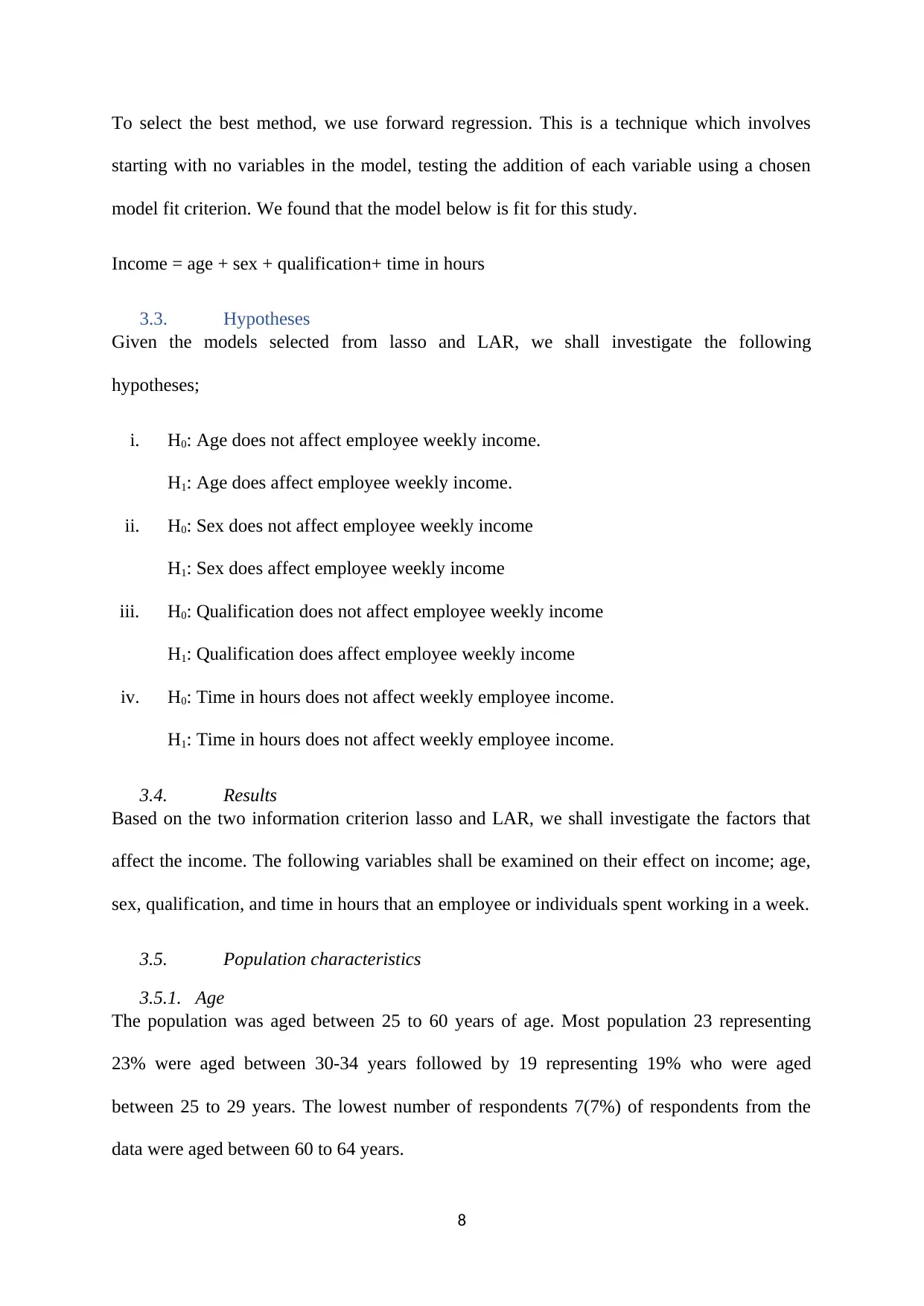
To select the best method, we use forward regression. This is a technique which involves
starting with no variables in the model, testing the addition of each variable using a chosen
model fit criterion. We found that the model below is fit for this study.
Income = age + sex + qualification+ time in hours
3.3. Hypotheses
Given the models selected from lasso and LAR, we shall investigate the following
hypotheses;
i. H0: Age does not affect employee weekly income.
H1: Age does affect employee weekly income.
ii. H0: Sex does not affect employee weekly income
H1: Sex does affect employee weekly income
iii. H0: Qualification does not affect employee weekly income
H1: Qualification does affect employee weekly income
iv. H0: Time in hours does not affect weekly employee income.
H1: Time in hours does not affect weekly employee income.
3.4. Results
Based on the two information criterion lasso and LAR, we shall investigate the factors that
affect the income. The following variables shall be examined on their effect on income; age,
sex, qualification, and time in hours that an employee or individuals spent working in a week.
3.5. Population characteristics
3.5.1. Age
The population was aged between 25 to 60 years of age. Most population 23 representing
23% were aged between 30-34 years followed by 19 representing 19% who were aged
between 25 to 29 years. The lowest number of respondents 7(7%) of respondents from the
data were aged between 60 to 64 years.
8
starting with no variables in the model, testing the addition of each variable using a chosen
model fit criterion. We found that the model below is fit for this study.
Income = age + sex + qualification+ time in hours
3.3. Hypotheses
Given the models selected from lasso and LAR, we shall investigate the following
hypotheses;
i. H0: Age does not affect employee weekly income.
H1: Age does affect employee weekly income.
ii. H0: Sex does not affect employee weekly income
H1: Sex does affect employee weekly income
iii. H0: Qualification does not affect employee weekly income
H1: Qualification does affect employee weekly income
iv. H0: Time in hours does not affect weekly employee income.
H1: Time in hours does not affect weekly employee income.
3.4. Results
Based on the two information criterion lasso and LAR, we shall investigate the factors that
affect the income. The following variables shall be examined on their effect on income; age,
sex, qualification, and time in hours that an employee or individuals spent working in a week.
3.5. Population characteristics
3.5.1. Age
The population was aged between 25 to 60 years of age. Most population 23 representing
23% were aged between 30-34 years followed by 19 representing 19% who were aged
between 25 to 29 years. The lowest number of respondents 7(7%) of respondents from the
data were aged between 60 to 64 years.
8
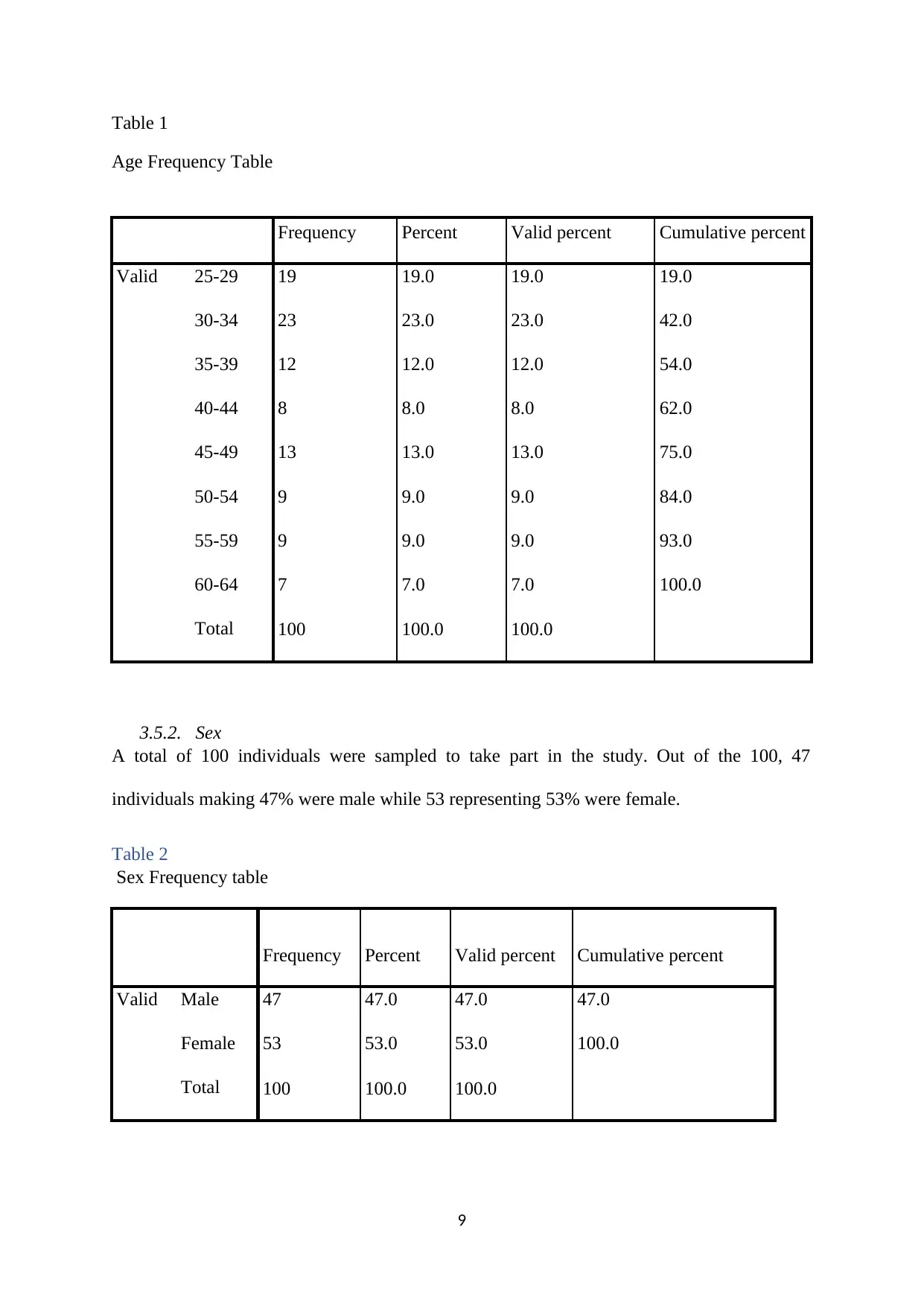
Table 1
Age Frequency Table
Frequency Percent Valid percent Cumulative percent
Valid 25-29 19 19.0 19.0 19.0
30-34 23 23.0 23.0 42.0
35-39 12 12.0 12.0 54.0
40-44 8 8.0 8.0 62.0
45-49 13 13.0 13.0 75.0
50-54 9 9.0 9.0 84.0
55-59 9 9.0 9.0 93.0
60-64 7 7.0 7.0 100.0
Total 100 100.0 100.0
3.5.2. Sex
A total of 100 individuals were sampled to take part in the study. Out of the 100, 47
individuals making 47% were male while 53 representing 53% were female.
Table 2
Sex Frequency table
Frequency Percent Valid percent Cumulative percent
Valid Male 47 47.0 47.0 47.0
Female 53 53.0 53.0 100.0
Total 100 100.0 100.0
9
Age Frequency Table
Frequency Percent Valid percent Cumulative percent
Valid 25-29 19 19.0 19.0 19.0
30-34 23 23.0 23.0 42.0
35-39 12 12.0 12.0 54.0
40-44 8 8.0 8.0 62.0
45-49 13 13.0 13.0 75.0
50-54 9 9.0 9.0 84.0
55-59 9 9.0 9.0 93.0
60-64 7 7.0 7.0 100.0
Total 100 100.0 100.0
3.5.2. Sex
A total of 100 individuals were sampled to take part in the study. Out of the 100, 47
individuals making 47% were male while 53 representing 53% were female.
Table 2
Sex Frequency table
Frequency Percent Valid percent Cumulative percent
Valid Male 47 47.0 47.0 47.0
Female 53 53.0 53.0 100.0
Total 100 100.0 100.0
9
⊘ This is a preview!⊘
Do you want full access?
Subscribe today to unlock all pages.

Trusted by 1+ million students worldwide
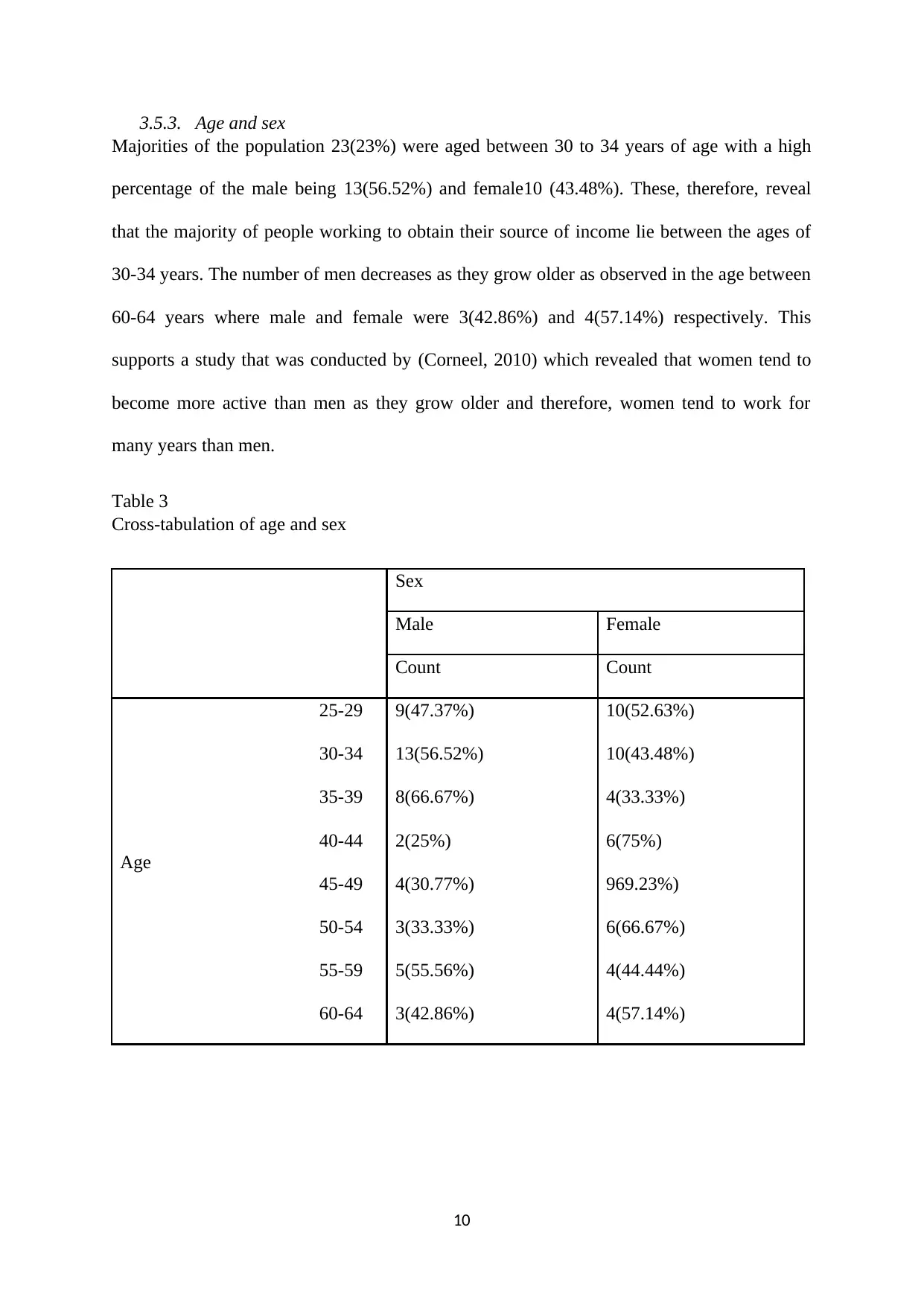
3.5.3. Age and sex
Majorities of the population 23(23%) were aged between 30 to 34 years of age with a high
percentage of the male being 13(56.52%) and female10 (43.48%). These, therefore, reveal
that the majority of people working to obtain their source of income lie between the ages of
30-34 years. The number of men decreases as they grow older as observed in the age between
60-64 years where male and female were 3(42.86%) and 4(57.14%) respectively. This
supports a study that was conducted by (Corneel, 2010) which revealed that women tend to
become more active than men as they grow older and therefore, women tend to work for
many years than men.
Table 3
Cross-tabulation of age and sex
Sex
Male Female
Count Count
Age
25-29 9(47.37%) 10(52.63%)
30-34 13(56.52%) 10(43.48%)
35-39 8(66.67%) 4(33.33%)
40-44 2(25%) 6(75%)
45-49 4(30.77%) 969.23%)
50-54 3(33.33%) 6(66.67%)
55-59 5(55.56%) 4(44.44%)
60-64 3(42.86%) 4(57.14%)
10
Majorities of the population 23(23%) were aged between 30 to 34 years of age with a high
percentage of the male being 13(56.52%) and female10 (43.48%). These, therefore, reveal
that the majority of people working to obtain their source of income lie between the ages of
30-34 years. The number of men decreases as they grow older as observed in the age between
60-64 years where male and female were 3(42.86%) and 4(57.14%) respectively. This
supports a study that was conducted by (Corneel, 2010) which revealed that women tend to
become more active than men as they grow older and therefore, women tend to work for
many years than men.
Table 3
Cross-tabulation of age and sex
Sex
Male Female
Count Count
Age
25-29 9(47.37%) 10(52.63%)
30-34 13(56.52%) 10(43.48%)
35-39 8(66.67%) 4(33.33%)
40-44 2(25%) 6(75%)
45-49 4(30.77%) 969.23%)
50-54 3(33.33%) 6(66.67%)
55-59 5(55.56%) 4(44.44%)
60-64 3(42.86%) 4(57.14%)
10
Paraphrase This Document
Need a fresh take? Get an instant paraphrase of this document with our AI Paraphraser
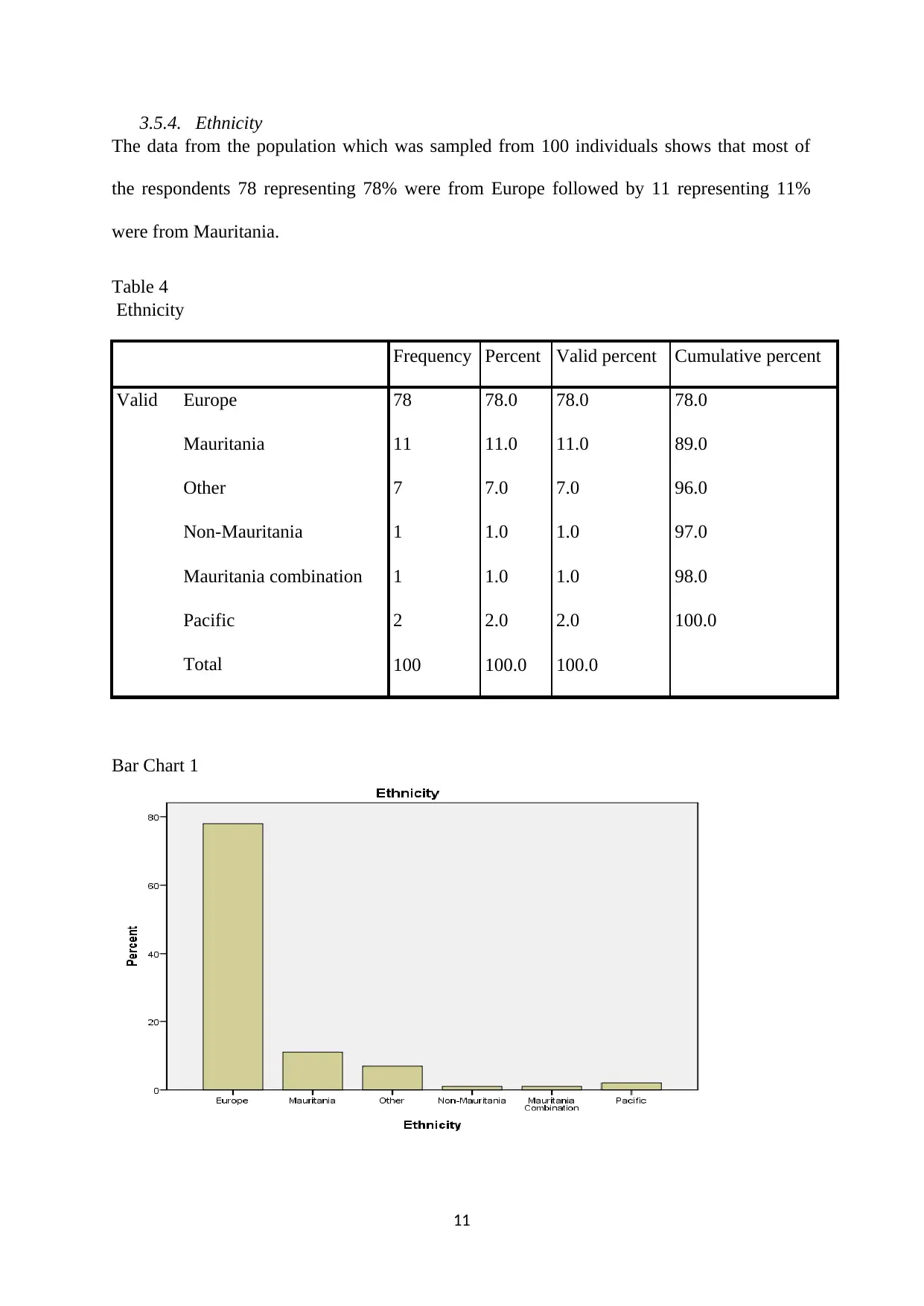
3.5.4. Ethnicity
The data from the population which was sampled from 100 individuals shows that most of
the respondents 78 representing 78% were from Europe followed by 11 representing 11%
were from Mauritania.
Table 4
Ethnicity
Frequency Percent Valid percent Cumulative percent
Valid Europe 78 78.0 78.0 78.0
Mauritania 11 11.0 11.0 89.0
Other 7 7.0 7.0 96.0
Non-Mauritania 1 1.0 1.0 97.0
Mauritania combination 1 1.0 1.0 98.0
Pacific 2 2.0 2.0 100.0
Total 100 100.0 100.0
Bar Chart 1
11
The data from the population which was sampled from 100 individuals shows that most of
the respondents 78 representing 78% were from Europe followed by 11 representing 11%
were from Mauritania.
Table 4
Ethnicity
Frequency Percent Valid percent Cumulative percent
Valid Europe 78 78.0 78.0 78.0
Mauritania 11 11.0 11.0 89.0
Other 7 7.0 7.0 96.0
Non-Mauritania 1 1.0 1.0 97.0
Mauritania combination 1 1.0 1.0 98.0
Pacific 2 2.0 2.0 100.0
Total 100 100.0 100.0
Bar Chart 1
11
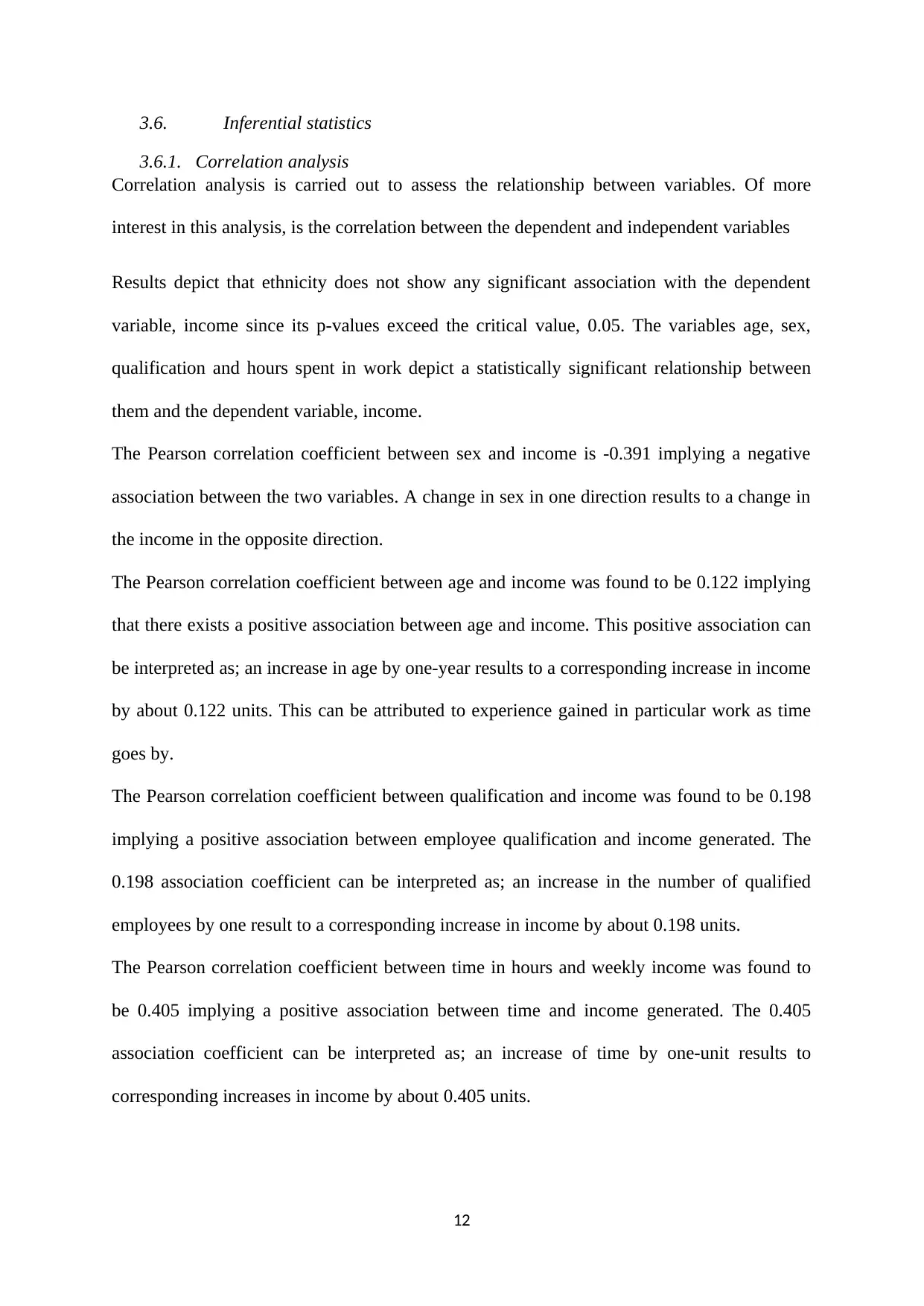
3.6. Inferential statistics
3.6.1. Correlation analysis
Correlation analysis is carried out to assess the relationship between variables. Of more
interest in this analysis, is the correlation between the dependent and independent variables
Results depict that ethnicity does not show any significant association with the dependent
variable, income since its p-values exceed the critical value, 0.05. The variables age, sex,
qualification and hours spent in work depict a statistically significant relationship between
them and the dependent variable, income.
The Pearson correlation coefficient between sex and income is -0.391 implying a negative
association between the two variables. A change in sex in one direction results to a change in
the income in the opposite direction.
The Pearson correlation coefficient between age and income was found to be 0.122 implying
that there exists a positive association between age and income. This positive association can
be interpreted as; an increase in age by one-year results to a corresponding increase in income
by about 0.122 units. This can be attributed to experience gained in particular work as time
goes by.
The Pearson correlation coefficient between qualification and income was found to be 0.198
implying a positive association between employee qualification and income generated. The
0.198 association coefficient can be interpreted as; an increase in the number of qualified
employees by one result to a corresponding increase in income by about 0.198 units.
The Pearson correlation coefficient between time in hours and weekly income was found to
be 0.405 implying a positive association between time and income generated. The 0.405
association coefficient can be interpreted as; an increase of time by one-unit results to
corresponding increases in income by about 0.405 units.
12
3.6.1. Correlation analysis
Correlation analysis is carried out to assess the relationship between variables. Of more
interest in this analysis, is the correlation between the dependent and independent variables
Results depict that ethnicity does not show any significant association with the dependent
variable, income since its p-values exceed the critical value, 0.05. The variables age, sex,
qualification and hours spent in work depict a statistically significant relationship between
them and the dependent variable, income.
The Pearson correlation coefficient between sex and income is -0.391 implying a negative
association between the two variables. A change in sex in one direction results to a change in
the income in the opposite direction.
The Pearson correlation coefficient between age and income was found to be 0.122 implying
that there exists a positive association between age and income. This positive association can
be interpreted as; an increase in age by one-year results to a corresponding increase in income
by about 0.122 units. This can be attributed to experience gained in particular work as time
goes by.
The Pearson correlation coefficient between qualification and income was found to be 0.198
implying a positive association between employee qualification and income generated. The
0.198 association coefficient can be interpreted as; an increase in the number of qualified
employees by one result to a corresponding increase in income by about 0.198 units.
The Pearson correlation coefficient between time in hours and weekly income was found to
be 0.405 implying a positive association between time and income generated. The 0.405
association coefficient can be interpreted as; an increase of time by one-unit results to
corresponding increases in income by about 0.405 units.
12
⊘ This is a preview!⊘
Do you want full access?
Subscribe today to unlock all pages.

Trusted by 1+ million students worldwide
1 out of 28
Your All-in-One AI-Powered Toolkit for Academic Success.
+13062052269
info@desklib.com
Available 24*7 on WhatsApp / Email
![[object Object]](/_next/static/media/star-bottom.7253800d.svg)
Unlock your academic potential
Copyright © 2020–2025 A2Z Services. All Rights Reserved. Developed and managed by ZUCOL.


